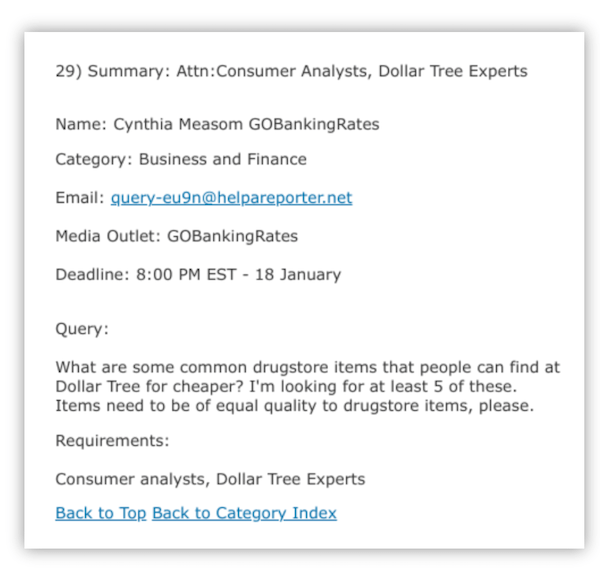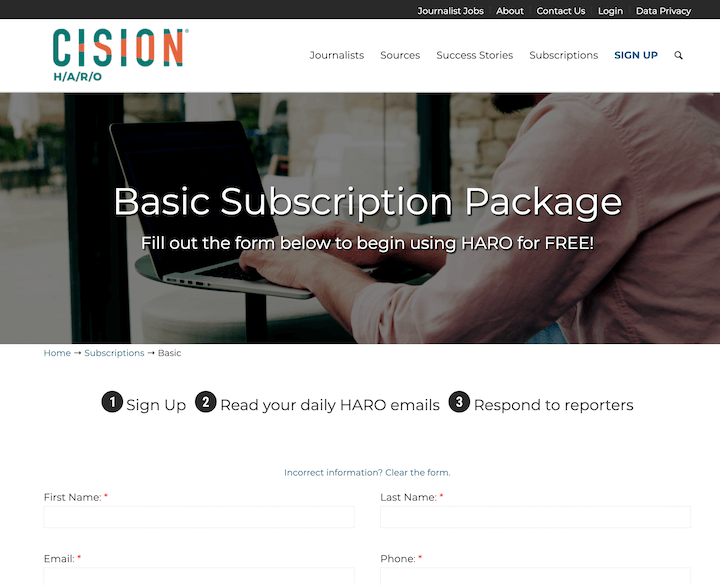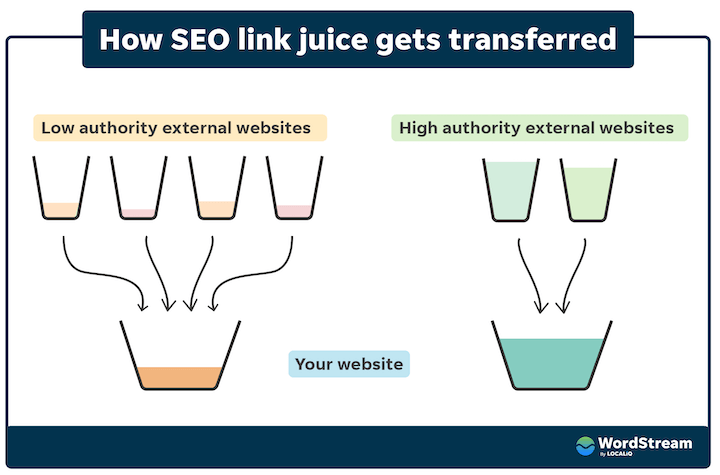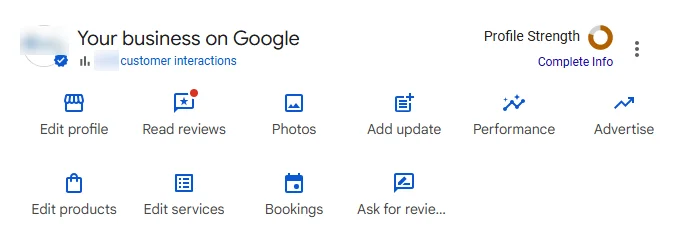Whether you’ve got a new business or established one, there are lots of different ways to get your name out there in front of the right people. You’ve got pillar strategies like SEO, PPC, social, and more, and then there are more niche tactics within those strategies that can be wildly effective if you know how to use them right.
One such tactic is through the platform Help a Reporter Out (HARO), which can help you to convey your expertise, build brand awareness, and improve your SEO through backlinks.

How so? Read on and I’ll show you:
- What HARO is and how it works
- How it can help you to build backlinks and brand awareness
- How to respond to HARO queries the right way
What is HARO?
Help a Reporter Out (HARO) is a platform by Cision where journalists, businesses, and individuals post queries asking for information, statistics, and perspectives they need for articles they are writing. Experts can then respond to these queries, and the journalist can then quote them in the article and will often provide a backlink to their site (if applicable).

An example of a query in HARO
Journalists can come from well-known publications, making HARO a great means of link building, which is crucial for SEO, while also building your brand awareness and media coverage. This platform is actually so effective that many HARO link-building services have sprung up in recent years, offering to obtain high-quality links from top media outlets (for a hefty price, of course).
How to set up a HARO account
To set up your HARO account, go to the HARO website and create a profile. You’ll need to provide your name, email address, and some basic information about your expertise and industry.

Then, customize your preferences to see requests specific to your area of expertise and define your preferred frequency of email notifications.
How to respond to HARO queries (template)
To get backlinks using HARO, it’s all about responding to the right queries at the right time, in the right way. And that’s what I’m going to walk you through now.
Here’s a basic template I recommend:
Hi [NAME]
My name is [NAME], and I have spent much of my career working as a [RELEVANT ROLE] ] at [COMPANY]. In [X years] of working in this industry, I have [LIST ACHIEVEMENTS]. Here’s my take on your query:
Start every pitch following this outline, and you will quickly notice more responses from journalists and new backlinks to your website.
Thanks in advance,
[NAME]
Some things you’ll notice:
- Address them by name.
- Thank the journalist for their time.
- Say that you are willing to follow up/be interviewed (don’t worry, journalists will virtually never do this, but it’s good to ask)
- Say thanks in advance. For some reason, this email signature is associated with the most positive responses.
But there’s more to a HARO pitch than this, of course, so in the next section, I’m going to provide some key tips.
Tips on using HARO for backlinks and PR
Below you’ll find my top tips for responding to HARO queries in a way that paints your business in the best light, actually lands you backlinks and PR, and develops relationships with journalists.
1. Check the media outlet’s domain rating
Domain rating, also known as domain authority—depending on which SEO platform you’re using—is an expression of your website’s SEO value. When you’re looking to build backlinks, the higher the backlinker’s DR, the more it will help you to increase yours.
That being said, checking the DR of the media outlet in question will help you to identify whether pitching to this journalist will be worth your time.

Use a tool like Ahrefs’ Free Website Authority Checker.
2. Only respond to relevant queries
Hundreds of HARO queries get posted every day, so you should only respond to those for which you have relevant experience (experience is now part of Google’s E-E-A-T formula, by the way!). In the example above, you can see in the requirements that Cynthia is looking for consumer analysts, so if you are one, have conducted research in the field, or have a relevant degree, you may be the perfect match.
3. Show your credentials
On that note, make it clear right away that you are a quality and credible source for them. State your credentials and relevant experience right away. And don’t underestimate the power of your own credibility. You don’t have to be Elon Musk to get a link from The New York Times!
4. Respond within 30 minutes
Time is of the essence for journalists, so being proactive with your responses is crucial. Most queries on HARO will have a pitch deadline, but the best advice is to try to be the first one to respond. Journalists are often looking for a quick quote to plug into their articles and press releases. They want convenience, not a life story.
Play to this and try to respond to a query within 30 minutes. Fast responses win HARO links!

5. Make it quantifiable and/or quotable
Journalists will take you much more seriously if you can reference case studies and statistics that back up your input. For example, instead of saying “Focusing on B2B sales is important” try “Focusing on B2B sales can lead to a 138% year-over-year return.”
Also, be quotable. Try and visualize your response in a Forbes article. Does it fit or sound clunky? Quotable excerpts are intelligent and memorable but brief and to the point. Being clear and concise with your copy will make it easier for journalists to select your pitches over others.
6. Don’t follow up until after you get a response
If you don’t get a response, the journalist has probably deleted your pitch because you’re not qualified and time is of the essence. Don’t keep chasing them. This will signal to the journalist you are just desperate for backlinks and/or media exposure and they’ll avoid you in the future.
7. Don’t expect every pitch to succeed
On HARO, a success rate between 5-10% is fairly common. Some specialists can get this a bit higher, but no one will acquire media coverage and a strong backlink for every pitch.
Stay positive and consistent with your HARO pitches. You can even delegate this to one of your employees if needed. But please don’t give up after writing a few pitches!
It’s not about the quantity of links you build but the quality of the links—and the quality of the relationships! Which is my next tip.

8. Focus on relationships
HARO isn’t a one-way street. It’s give and take. Focus not on building backlinks, but on building relationships with journalists. Share the article with your network, and follow up with journalists to thank them, let them know you’ve shared it, and offer to help with new articles.
9. Track your success
As you know, not all links are created equally. Context, relevancy, and authority all influence how search engines determine a website’s ranking power.
Create a spreadsheet to track your success. It can be as simple as “Publication Name” and “Yes/No” or it can be a little more sophisticated (like this one).
![]()
This will help you measure, optimize, and scale your link-building efforts.
10. Sign up for Google Alerts
On a similar note, it’s a good idea to sign up for Google Alerts so that you will get a notification every time you earn a new link. Also, be sure to regularly run site searches and check SEO tools to find new backlinks.
Speaking of SEO tools, have you used our Free Website Grader?
Get a free audit of your website in less than a minute!
This can help you to identify patterns and trends in the type of backlinks you are getting e.g. topics, pitch style, etc.
From here, you can make much more data-driven decisions about HARO link building and whether it can viably fit into your long-term SEO strategy.
11. Use it as a larger backlink strategy
In the same way that different backlinks hold different levels of value, there are also many different ways to build links besides HARO.
Other ways to build backlinks include guest posting, niche content, statistic posts, infographics, content syndication, and lead magnets like free tools. Diversifying your efforts will help your backlink profile to grow naturally, with varied anchor text, and across multiple channels.
Start building backlinks with HARO
HARO outreach is one of the best ways for businesses to increase brand awareness, generate referral traffic, and, most importantly, build high-quality backlinks. Plus, seeing your business get featured in the media is very gratifying. Follow these HARO tips and best practices, and you will get to experience it yourself!
About the author
Matt Shirley is the founder of Splinter Economics. He aims to provide guidance in all areas of business and marketing, but he does have a soft spot for SEO.
The post How to Use HARO for Backlinks & PR (with a Free Pitch Template) appeared first on WordStream.




Recent Comments